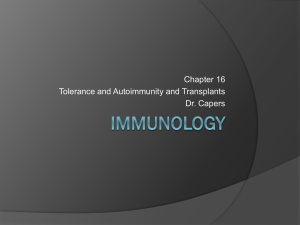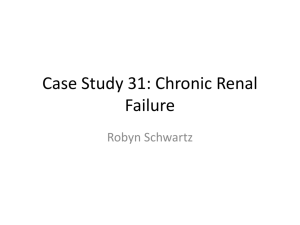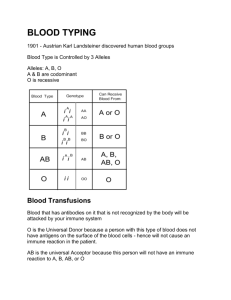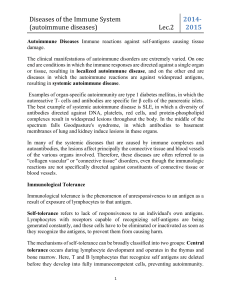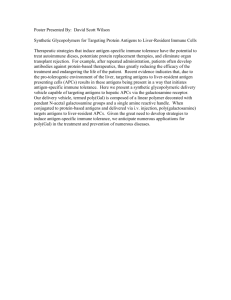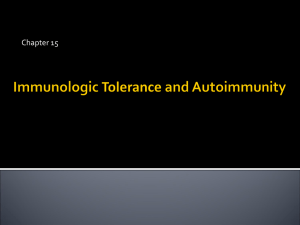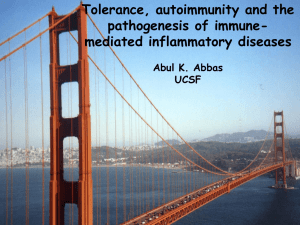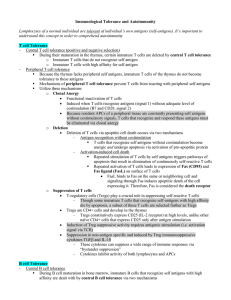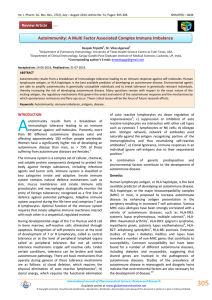Autoimmunity 3rd yr
advertisement
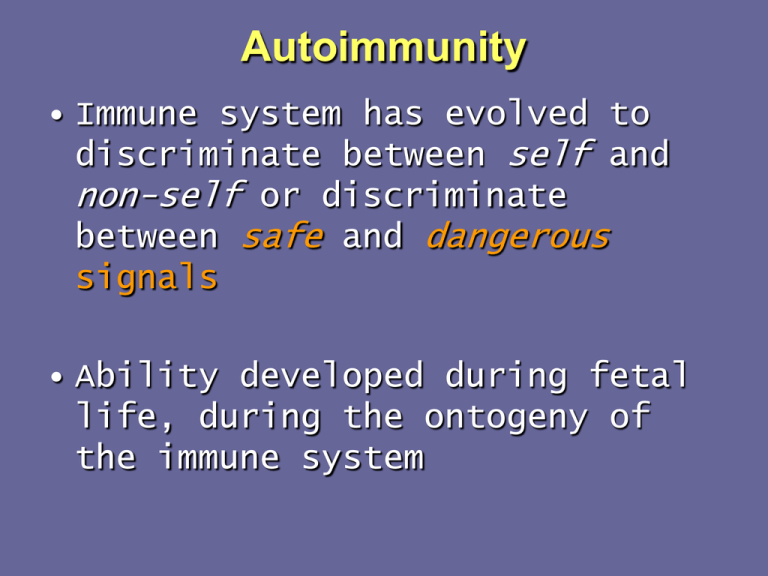
Autoimmunity • Immune system has evolved to discriminate between self and non-self or discriminate between safe and dangerous signals • Ability developed during fetal life, during the ontogeny of the immune system • Termed tolerance, a form of censorship of the immune system • Deletion (clonal deletion) or functional inactivation (clonal anergy) of developing lymphocytes that possess antigenic receptors with high affinity for self-antigens Central and Peripheral Tolerance (Absence of Co-stimulation) B Cell Tolerance to Self Antigens Developing B lymphocytes recognizing cell-associated self antigens are effectively deleted. Developing B lymphocytes recognizing soluble self antigens are less efficiently deleted. B Cell Tolerance to Self Antigens Sequestered Antigens Induction of tolerance in selfreactive T cells occurs through the exposure of immature T cells to self-antigens in the thymus. The elimination/silencing of all self-reactive T cells requires that all self-antigens be presented within the thymic environment. Some self-antigens are sequestered in specialized tissues and may not be expressed in the thymus. These are not seen by the developing immune system – will not induce selftolerance. Exposure of T cells to these normally sequestered/tissue-specific self-antigens in the periphery results in their activation Examples of Sequestered Antigens Myelin basic protein (MBP), associated with MS. Sperm-associated antigens in some individuals following vasectomy. Lens and corneal proteins of the eye following infection or trauma. Heart muscle antigens following myocardial infarction. Autoimmune Diseases Self-reactive lymphocytes (the forbidden clones) should be eliminated from the immunological repertoire. Diseases involving an immunological response to normal tissue – termed autoimmunity or autoimmune diseases. Original concept – the receptors of lymphocytes with specificity for foreign antigens underwent mutation – results in a new class of receptors with specificity for self-antigens. It is now clear that autoantibodies and self-reactive T cells are normal components of the immune repertoire. Autoimmunity with Diseases Results from: 1- Mistake in selection of B cell and T cells 2- Broken tolerance 3- Antibody, and T cell activation against self antigens The Spectrum of autoimmune Diseases Organ specific Systemic Hashimoto’s thyroiditis Pernicious anaemia Insulin dependent diabetes Myasthenia gravis Multiple sclerosis Ulcerative colitis Rheumatoid arthritis Systemic lupus erythematous Pathology of Autoimmune Diseases Most of the autoimmune diseases attributed to autoantibodies. Disease processes and tissue damage are due to Type II and Type III hypersensitivity reactions. Other autoimmune diseases have an autoreactive T cell component. Disease process and tissue damage due to Type IV hypersensitivity reactions. Autoimmune Diseases due to Type II Hypersensitivity Autoimmune Diseases A. Type II (Cytotoxic) Autoimmune Reactions Involve antibody reactions to cell surface molecules, without cytotoxic destruction of cells. – Grave’s Disease: • Antibodies attach to receptors on thyroid gland and stimulate production of thyroid hormone. • Symptoms: Goiter (enlarged thyroid) and bulging eyes. – Myasthenia gravis: • Progressive muscle weakness. Antibodies block acetylcholine receptors at neuromuscular synapse. • Today most patients survive when treated with drugs or immunosuppressants. B. Type III (Immune Complex) Autoimmune Reactions – Systemic Lupus Erythematosus: • Name derived from red skin rash on face. • Autoantibodies react against DNA, blood cells, neurons, and other tissues. • When cells die, immune complexes form and deposit under skin, joints, in kidneys, blood vessels, and central nervous system. • Inflammation interferes with normal function of these sites (arthritis, rash, kidney damage). • Most patients die from kidney damage. • No cure. Symptoms treated with anti-inflammatory and immunosuppressive drugs. Type III (Immune Complex) Autoimmune Reactions (Continued) – Rheumatoid Arthritis: • Cause unknown, but microbial mimicry may be involved. • IgM autoantibodies (rheumatoid factors) against IgG form complexes in joint, leading to inflammation and cartilage damage. • Often causes finger and joint deformities. • No cure. Symptoms treated with anti-inflammatory (aspirin) and immunosuppressive drugs. Physical therapy keeps joints movable. Surgical replacement of joints may be necessary. Rheumatoid Arthritis Morning stiffness, joint swelling, subcutaneous rheumatic nodes, Auto antibodies. Associated with HLA-DR4. Molecular mimicry with bacterial antigen T cells found to react with autoantigen IgM auto-antibodies Anti nuclear antibodies C. Type IV (Cell-Mediated) Autoimmune Reactions (Continued) – Insulin-dependent (Type I or Juvenile) Diabetes Mellitus: Makes up 10% of diabetes cases. Characterized by insufficient insulin production due to immunological destruction of insulin-secreting cells of the pancreas by T cells. Usually develops before the age of 15. Treated with insulin injections. • Symptoms: Hyperglycemia, abnormal Hunger, increased thirst, Polyuria, and glycosuria • Immune component: Antibody against insulin, and glutamic acid decorboxylase (GADD) • Cellular infiltrates of CD4+ and CD8 + T cells • Inflammatory cytokines in lessons. • Rota virus, Coxsackie virus Multiple Sclerosis: Demyelinating disease, early sign neuritis Immune component: Myelin specific antibodies in cerebral fluid Antibody dependent cellular cytotoxicity in tissue damage CD4 +T cell mediated disease Th1 cytokines are associated with disease, Th2 cytokines are protective. Broken tolerance in APC by infection Epitope spreading corona virus detected in serum of MS patients. Proposed Mechanisms of Autoimmunity

